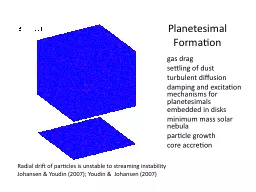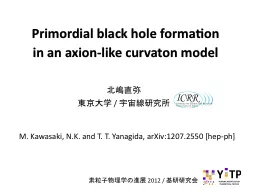PPT-Planetesimal Formation
Author : alida-meadow | Published Date : 2016-10-28
gas drag settling of dust turbulent diffusion damping and excitation mechanisms for planetesimals embedded in disks minimum mass solar nebula particle growth core
Presentation Embed Code
Download Presentation
Download Presentation The PPT/PDF document "Planetesimal Formation" is the property of its rightful owner. Permission is granted to download and print the materials on this website for personal, non-commercial use only, and to display it on your personal computer provided you do not modify the materials and that you retain all copyright notices contained in the materials. By downloading content from our website, you accept the terms of this agreement.
Planetesimal Formation: Transcript
Download Rules Of Document
"Planetesimal Formation"The content belongs to its owner. You may download and print it for personal use, without modification, and keep all copyright notices. By downloading, you agree to these terms.
Related Documents














